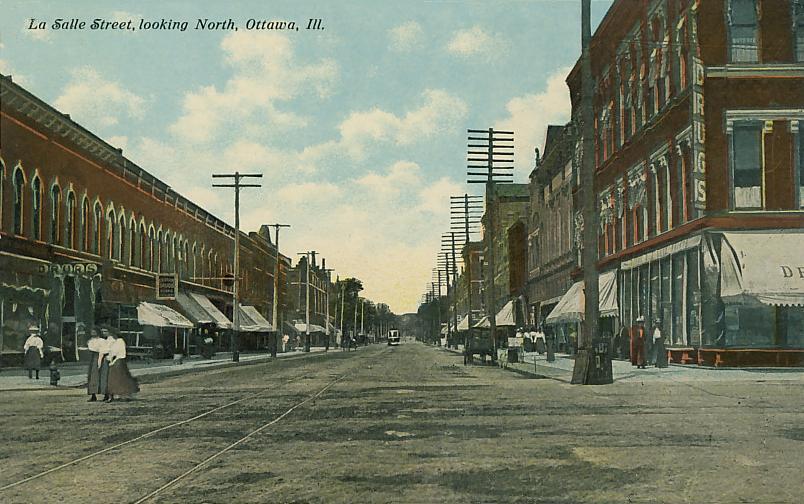|
Stephen Mack, Jr.
Stephen Mack Jr. (February 2, 1798 – April 10, 1850) adventurer and pioneer, American Fur Company employee, founder of Rockton, Illinois. Biography Background and early life 1798–1819 Born in Tunbridge, Vermont, he was the son of Stephen and Temperance (Bond) Mack. Stephen, Jr. was a first cousin to Joseph Smith, the founder of the Latter Day Saint movement, and when the Latter-day Saints moved to Utah, Stephen's mother accompanied them. Stephen Mack, Sr. was engaged in the mercantile business at Tunbridge until 1807 when he went to Detroit, leaving his wife and family behind. The senior Mack valued education, and knowing that there was little opportunity in such a remote frontier village, he had his family remain in Vermont. The younger Mack would later pursue for himself a level of education uncommon for his time, and when he had children of his own, he was very active in procuring for them the best educational opportunities. Stephen Mack, Sr. was the first English ... [...More Info...] [...Related Items...] OR: [Wikipedia] [Google] [Baidu] |
American Fur Company
The American Fur Company (AFC) was founded in 1808, by John Jacob Astor, a German immigrant to the United States. During the 18th century, furs had become a major commodity in Europe, and North America became a major supplier. Several British companies, most notably the North West Company and the Hudson's Bay Company, were eventual competitors against Astor and capitalized on the lucrative trade in furs. Astor capitalized on anti-British sentiments and his commercial strategies to become one of the first trusts in American business and a major competitor to the British commercial dominance in North American fur trade. Expanding into many former British fur-trapping regions and trade routes, the company grew to monopolize the fur trade in the United States by 1830, and became one of the largest and wealthiest businesses in the country. Astor planned for several companies to function across the Great Lakes, the Great Plains and the Oregon Country to gain control of the North Am ... [...More Info...] [...Related Items...] OR: [Wikipedia] [Google] [Baidu] |
Green Bay, Wisconsin
Green Bay is a city in the U.S. state of Wisconsin. The county seat of Brown County, it is at the head of Green Bay (known locally as "the bay of Green Bay"), a sub-basin of Lake Michigan, at the mouth of the Fox River. It is above sea level and north of Milwaukee. As of the 2020 Census, Green Bay had a population of 107,395, making it the third-largest in the state of Wisconsin, after Milwaukee and Madison, and the third-largest city on Lake Michigan, after Chicago and Milwaukee. Green Bay is the principal city of the Green Bay Metropolitan Statistical Area, which covers Brown, Kewaunee, and Oconto counties. Green Bay is well known for being the home city of the National Football League (NFL)'s Green Bay Packers. History Samuel de Champlain, the founder of New France, commissioned Jean Nicolet to form a peaceful alliance with Native Americans in the western areas, whose unrest interfered with French fur trade, and to search for a shorter trade route to China throu ... [...More Info...] [...Related Items...] OR: [Wikipedia] [Google] [Baidu] |
Ottawa, Illinois
Ottawa is a city located at the confluence of the navigable Illinois River and Fox River in LaSalle County, Illinois, United States. The Illinois River is a conduit for river barges and connects Lake Michigan at Chicago, to the Mississippi River, and North America's 25,000 mile river system. The population estimate was 18,742, as of 2020. It is the county seat of LaSalle County and it is the principal city of the Ottawa, IL Micropolitan Statistical Area. History Ottawa occupies a place on the Illinois River that has long been one end of a portage trail between the Mississippi River and Lake Michigan. Here the river was reliably deep enough for canoes. The North Portage Trail connected the site over land and water to the Chicago River. Ottawa was the site of the first of the Lincoln–Douglas debates on August 21, 1858. During the Ottawa debate, Stephen A. Douglas, leader of the Democratic Party, openly accused Abraham Lincoln of forming a secret bipartisan group of Congressm ... [...More Info...] [...Related Items...] OR: [Wikipedia] [Google] [Baidu] |
Indian Creek Massacre
The Indian Creek Massacre occurred on May 21, 1832 with the attack by a party of Native Americans on a group of United States settlers in LaSalle County, Illinois following a dispute about a settler-constructed dam that prevented fish from reaching a nearby Potawatomi village. The incident coincided with the Black Hawk War, but it was not a direct action of the Sauk leader Black Hawk and conflict with the United States. The removal of the dam was asked, was rejected by the settlers and between 40 and 80 Potawatomis and three Sauks attacked and killed fifteen settlers, including women and children.Paging Back Tale of Indian Creek Massacre... [...More Info...] [...Related Items...] OR: [Wikipedia] [Google] [Baidu] |
Black Hawk (chief)
Black Hawk, born ''Ma-ka-tai-me-she-kia-kiak'' (Sauk: ''Mahkatêwe-meshi-kêhkêhkwa'') (1767 – October 3, 1838), was a Sauk people, Sauk leader and warrior who lived in what is now the Midwestern United States. Although he had inherited an important historic sacred bundle from his father, he was not a hereditary civil chief. Black Hawk earned his status as a war chief or captain by his actions: leading raiding and war parties as a young man and then a band of Sauk warriors during the Black Hawk War of 1832. During the War of 1812, Black Hawk fought on the side of the United Kingdom of Great Britain and Ireland, British against the US in the hope of pushing white American settlers away from Sauk territory. Later, he led a band of Sauk and Fox warriors, known as the British Band, against white settlers in Illinois and present-day Wisconsin during the 1832 Black Hawk War. After the war, he was captured by US forces and taken to the Eastern US, where he and other war leaders were ... [...More Info...] [...Related Items...] OR: [Wikipedia] [Google] [Baidu] |
Black Hawk War
The Black Hawk War was a conflict between the United States and Native Americans led by Black Hawk, a Sauk leader. The war erupted after Black Hawk and a group of Sauks, Meskwakis (Fox), and Kickapoos, known as the "British Band", crossed the Mississippi River, into the U.S. state of Illinois, from Iowa Indian Territory in April 1832. Black Hawk's motives were ambiguous, but he was apparently hoping to reclaim land sold to the United States in the disputed 1804 Treaty of St. Louis. U.S. officials, convinced that the British Band was hostile, mobilized a frontier militia and opened fire on a delegation from the Native Americans on May 14, 1832. Black Hawk responded by successfully attacking the militia at the Battle of Stillman's Run. He led his band to a secure location in what is now southern Wisconsin and was pursued by U.S. forces. Meanwhile, other Native Americans conducted raids against forts and colonies largely unprotected with the absence of the militia. Some Ho ... [...More Info...] [...Related Items...] OR: [Wikipedia] [Google] [Baidu] |
Hononegah
{{Infobox Native American leader , name = Hononegah , image = , image_size = , caption = , tribe = Pottawatomie, Ho-Chunk , lead = , birth_date = 1814 , birth_place = Teejopera (day-jope-ra), or "Four Lakes Country", modern day Madison, Wisconsin. , death_date = September 8, 1847 , death_place = , predecessor = , successor = , native_name = , nicknames = , known_for = , death_cause = , resting_place = , rp_coordinates = , religion = , party = , education = , spouse = Stephen Mack Jr. , children = Rosa, Myrtle Matilda , parents = Father, "Blacksmith" mother, Inoquer , relations = Sister, Wehunsegah; uncles Conosaipkah, Estche-eshesheek, and Horohonkak , signature = , footnotes = Hononegah (c.1814–1847) was the wife of Stephen Mack Jr. an employee for The America ... [...More Info...] [...Related Items...] OR: [Wikipedia] [Google] [Baidu] |
Chicago, Illinois
(''City in a Garden''); I Will , image_map = , map_caption = Interactive Map of Chicago , coordinates = , coordinates_footnotes = , subdivision_type = Country , subdivision_name = United States , subdivision_type1 = State , subdivision_type2 = Counties , subdivision_name1 = Illinois , subdivision_name2 = Cook and DuPage , established_title = Settled , established_date = , established_title2 = Incorporated (city) , established_date2 = , founder = Jean Baptiste Point du Sable , government_type = Mayor–council , governing_body = Chicago City Council , leader_title = Mayor , leader_name = Lori Lightfoot ( D) , leader_title1 = City Clerk , leader_name1 = Anna Valencia ( D) , unit_pref = Imperial , area_footnotes = , area_tot ... [...More Info...] [...Related Items...] OR: [Wikipedia] [Google] [Baidu] |
Pierre St
Pierre is a masculine given name. It is a French form of the name Peter. Pierre originally meant "rock" or "stone" in French (derived from the Greek word πέτρος (''petros'') meaning "stone, rock", via Latin "petra"). It is a translation of Aramaic כיפא (''Kefa),'' the nickname Jesus gave to apostle Simon Bar-Jona, referred in English as Saint Peter. Pierre is also found as a surname. People with the given name * Abbé Pierre, Henri Marie Joseph Grouès (1912–2007), French Catholic priest who founded the Emmaus Movement * Monsieur Pierre, Pierre Jean Philippe Zurcher-Margolle (c. 1890–1963), French ballroom dancer and dance teacher * Pierre (footballer), Lucas Pierre Santos Oliveira (born 1982), Brazilian footballer * Pierre, Baron of Beauvau (c. 1380–1453) * Pierre, Duke of Penthièvre (1845–1919) * Pierre, marquis de Fayet (died 1737), French naval commander and Governor General of Saint-Domingue * Prince Pierre, Duke of Valentinois (1895–1964), father ... [...More Info...] [...Related Items...] OR: [Wikipedia] [Google] [Baidu] |
Grand Detour, Illinois
Grand Detour is an unincorporated census-designated place in Ogle County, Illinois, United States. As of the 2010 census, its population was 429. The village is named after an odd turn in the Rock River, which flows north past the village, rather than its normal southwestern course. John Deere invented the steel plow in Grand Detour, and the John Deere House and Shop is a U.S. National Historic Landmark. Demographics History Grand Detour was founded in 1835 by Leonard Andrus (1805–1867) of Vermont. In 1836 Andrus welcomed his friend and fellow Vermont native John Deere to the town, where Deere built a house and established a forge. Deere manufactured pitchforks and shovels, and in 1837 he invented the first successful steel plow. The first was sold in 1838.Leffingwell, Randy.John Deere: A History of the Tractor" (Google Books), MotorBooks/MBI Publishing Company, 2004, pg. 10, (). Retrieved May 21, 2007. The John Deere Historic Site in Grand Detour is operated by the John D ... [...More Info...] [...Related Items...] OR: [Wikipedia] [Google] [Baidu] |
Hononegah Forest Preserve
{{Infobox Native American leader , name = Hononegah , image = , image_size = , caption = , tribe = Pottawatomie, Ho-Chunk , lead = , birth_date = 1814 , birth_place = Teejopera (day-jope-ra), or "Four Lakes Country", modern day Madison, Wisconsin. , death_date = September 8, 1847 , death_place = , predecessor = , successor = , native_name = , nicknames = , known_for = , death_cause = , resting_place = , rp_coordinates = , religion = , party = , education = , spouse = Stephen Mack Jr. , children = Rosa, Myrtle Matilda , parents = Father, "Blacksmith" mother, Inoquer , relations = Sister, Wehunsegah; uncles Conosaipkah, Estche-eshesheek, and Horohonkak , signature = , footnotes = Hononegah (c.1814–1847) was the wife of Stephen Mack Jr. an employee for The America ... [...More Info...] [...Related Items...] OR: [Wikipedia] [Google] [Baidu] |





